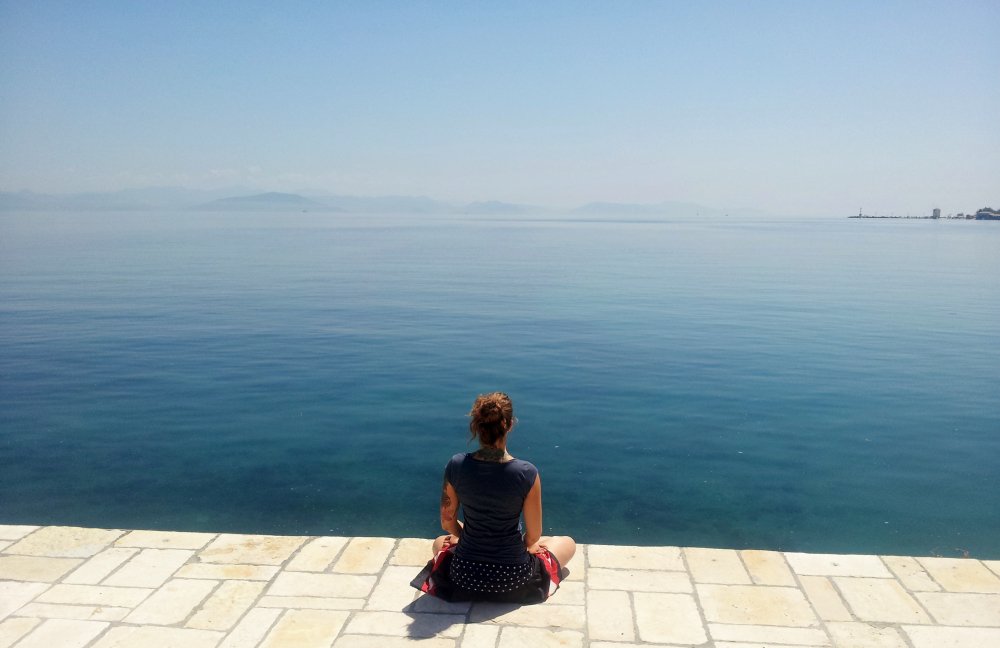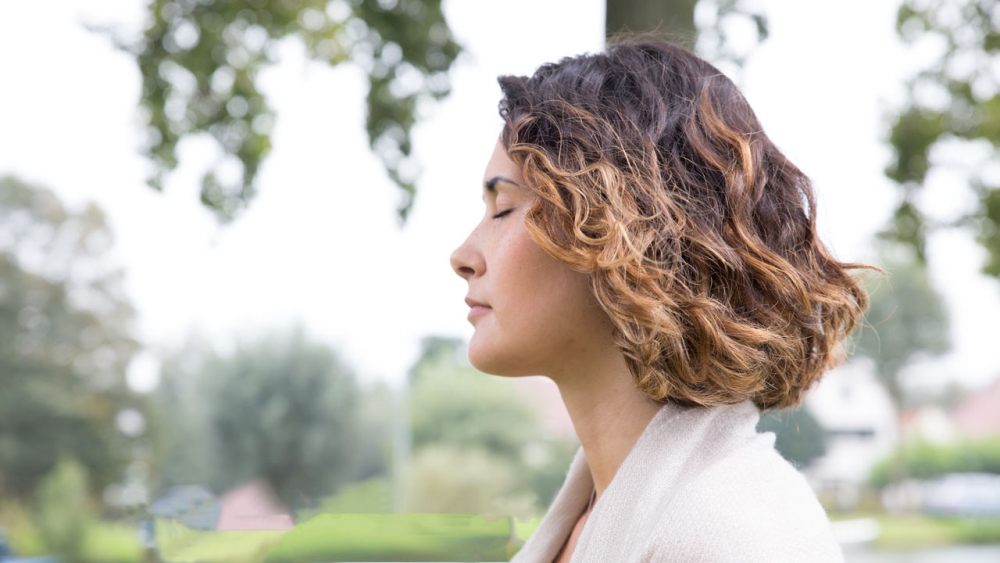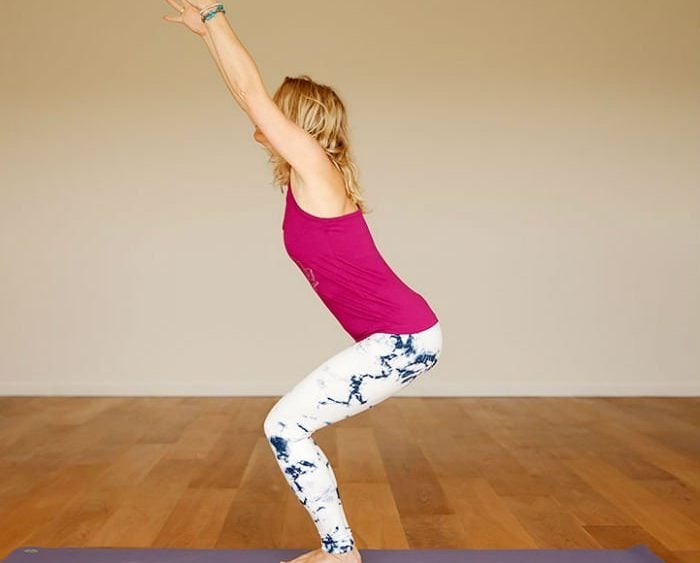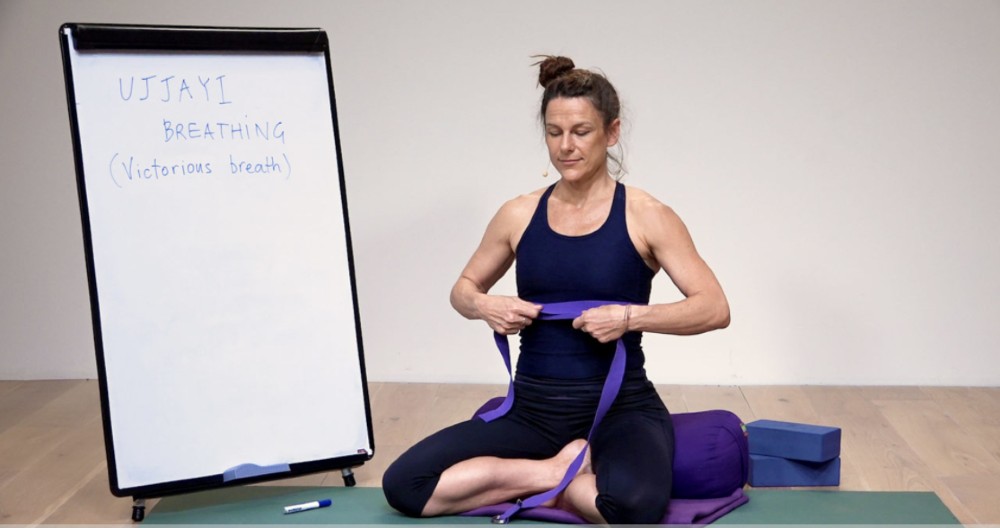Ujjayi Pranayama (breath regulating technique) is a soft, whispering breath which you’ll also hear called victorious breath, or perhaps ocean breath. It’s compared to the sound of the wind through the trees or the waves coming to shore.
Below are the Sanskrit terms key to Ujjayi Pranayama:
- Ujjayi: Victory over
- Pranayama: Prana – life force, breath; Yama – control, restraint, regulation
The mechanics of Ujjayi breath
With Ujjayi breath you breathe in and out of the nose with the lips sealed – no breath passes the lips. This also serves to build heat in the body. The lips gently close and although the breath is passing through the nostrils the emphasis is in your throat.
You create a constriction in the throat as if breathing in and out of a thin straw. Whilst maintaining a closed mouth position be mindful of held tension in the teeth, jaw, throat and/or neck – let it go. You can feel the breath stroke the back of your throat as you inhale and exhale. This comes hand in hand with the audibility of the breath, compared often to the sound of waves, Darth Vader and my husband in deep sleep. The tone, the audibility is smooth and steady, continuous uninterrupted cycles of inhales and exhales, often you cannot tell the difference in sound between the exchange of in and out breath cycles.
Sama Vritti
Sama: same Vritti: whirlings, fluctuations, modifications
Along with the even tone of breath, the length of the breath is the same on the inhale as it is on the exhale. You complete a full in-breath within the same time as you complete your out-breath. Using a metronome is a brilliant practice, if you are a musician you might have one already but if not there are some great online/phone applications that I’ve used with my students before. Set your metronome at 75 bpm, inhale for 4 beats, exhale for 4. An app that accents/ punctuates the beginning of each new cycle of breath is preferable.
With an even tone and length of breath, the last refinement is to breathe fully, deeply and completely (air volume of breath). Within each cycle you spend the entire inhale filling up and entire exhale releasing breath – at no point do you hold the breath – seamless and smooth, try not let the breath run out.
A Beginners’ Guide to Ujjayi Breath
I tend to instruct students who are beginners to breathe with their mouths open to get used to the physical sensation at their throats and sound of breath.
- Sit in a comfortable seat, where your sit bones are grounded and bearing even weight on both sides. Knees no higher than hips. Stacking head over neck, neck over shoulders, 4 corners of ribs stacking 4 corners of hips. Perceive equal length in both sides of your body, spine feels lifted and tall. Chin is parallel to earth.
- Rest one hand on your lap/ thigh, Palm facing up or down and the other hand at the same height and in front of your mouth, Palm facing towards you.
- With your mouth open exhale into your palm, imagining you are steaming up a mirror/ glass and feeling the warm breath on your palm. On your next inhale keep the hand where it is, breathe in making that same sound. Practise this for up to 10 cycles (4 count in, 4 count out, x10). Notice if you find the inhale or exhale more difficult.
- When you feel comfortable here move on to closing your mouth on the inhale but opening mouth on the exhale. See if you can maintain the sound even with the lips are sealed. Next inhale with mouth open and exhale with mouth closed, keeping sensation in your throat and the sound of breath the same. Do each for 5-10 cycles.
- When you feel you want to move on from here, relax your hand and begin Ujjayi Pranayama. You might time yourself with a stopwatch for 2 minutes or chose how many cycles of breath you want to aim for (feel free to use the metronome here).
- Again notice where resistance lies in the breath. Maybe you find the audibility awkward, equalising the volume of breath on both inhale and exhale difficult, or you notice the discrepancy of ease between in-breath and out-breath. Notice where you need to focus and what you need to practise on. I recommend that my students shorten the longer breath to meet the shorter breath if they are unable to stretch the breath evenly on both sides. You don’t want to feel out of breath or gasping at any point. There is absolutely NO RETENTION, it’s like a continuous sea of waves, no holding, totally fluid and seamless. Equanimous.
When to use Ujjayi breath
You can practise Ujjayi breath any time you wish. You don’t have to be on your yoga mat. But if you are on your yoga mat, acknowledge that the breath creates heat in the body. If you are doing a Yin or Restorative yoga class you may not want to add this element of heat in the body. Instead you might want to maintain a soft and fluid breath without sound. There also might be times in your practice where adding heat is inappropriate (e.g some pregnant practitioners find Ujjayi breath too heating to maintain for an entire practice) or where breathing in and out of the nose is impossible (e.g. blocked sinuses). At times like this you might want to keep the intention of Ujjayi breath in mind without practising it.
When I first heard my teacher Cat Alip-Douglas describe the breath as “non-preferential” the breath took on a deeper level of meaning and intention. Ujjayi breath is a pragmatic teaching of equanimity, non-attachment, not being swayed by the pulls of our desire to feel good (Raga) and repulsion when we feel bad (Dvesha).
Ujjayi in practice
Notice when you’re next holding Utkatasana / Chair pose for 5 breaths, you’re doing your tenth Surya Namaskar B (sun salutation B), or you’re holding pigeon pose for 20 breaths…Your breath shows you where you are holding, where you are finding it hard to let go, where you are over exerting.
Not only does Ujjayi hold a mirror up to your existing unconscious habits but it soon becomes a new habit, one that can soothe, lull and seduce your body and mind into a state of increased and progressive ease. You can sit in the fire of a posture (or an emotion), feel the heat yet feel radically calm and undisturbed. Now take that off your mat into your next review with your boss, when dealing with your toddler’s tantrums, or an argument with your partner.
Your yoga tool box
Your victory and triumph is the composure you learn to maintain by sticking with it, grounding yourself in your considered and calm breath. Unwavering. I remember being particularly upset early last year and after a heated conversation with a loved one, stood up, slammed the door (yes, yoga teachers do it sometimes too!) and sat outside hyperventilating.
I heard a gentle voice encouraging me to breathe Ujjayi breath. [FACT – you cannot hyperventilate or even cry and breathe Ujjayi breath at the same time.] Pretty instantly my entire system slowed down and a sense of calm came over me. In your yoga tool box you’ve got this breath technique, this antidote, wherever you go. I find it so empowering to be able to cultivate these inner resources whereby I can learn to tune in and switch from a reactive state to a proactive state of experiencing. This is the magic of breath.
EkhartYoga members – put this into practice
Explore the sound of the Ujjayi breath in this 15 minute tutorial with Tashi Dawa.
Ujjayi breath and the nervous system
From our very first breath until our final exhale we are, without any deliberate effort, continuously breathed by our Autonomic Nervous system (ANS). Unlike other ANS actions in the body (like pupil dilation) we are able to take voluntary control over our breathing and thus, critically, can influence our Sympathetic and Parasympathetic Nervous system.
When we breathe Ujjayi breath we transform the automatic into the deliberate and thereby become the master of our internal landscape; we can positively affect how we feel by regulating the length, air volume and sound of our inhales and exhales.
Ujjayi Pranayama is another tool to add to our box, another practice which encourages the mind to rest its awareness on the present moment, and identify with our immediate experience.

Yoga is a practice of integration and deliberate identification. Ujjayi Pranayama is another tool to add to our box, another practice which encourages the mind to rest its awareness on the present moment, and identify with our immediate experience. This process of mindfulness can be one of our biggest conquests. Mastery of the conscious mind. We become absorbed as we synchronise our movement with our breath. Our level of agitation settles, the fluctuations of our mind (chitta vritti) decelerate and for glimpses of a moment we are ‘all in’. As we learn to regulate the gross body through different yogic practices including pranayama, we can access and influence our subtle bodies.
Alchemy of breath
Many of us never learned Ujjayi breath formally before rocking up to class, rolling out our mats and being instructed to use the breath throughout our practice. We heard fellow students around us making a funny noise and felt slightly awkward when trying to copy them, feeling sure that we would get it wrong, which would expose us as newbies and imposters – oh the shame!
It is not uncommon to feel self-conscious when first making sound with breath, and then you pluck up the courage to try and a big snorting sound comes out. Like all things Yoga it takes practise and a relinquishment of self-identified inhibition – which also takes practice!
Like all things Yoga, Ujjayi breath takes practice and a relinquishment of self-identified inhibition (which also takes practise!)…but it’s a key that unlocks many doors and can transform your practice.
Which breath, which style?
Some styles of yoga (e.g. Ashtanga & Jivamukti) and certain teachers are more breath-focused than others, meaning they call/instruct each and every inhale and exhale throughout the class. They become a human metronome setting the rhythm which you begin to internalise. In other classes you will not be breath-led in this way which as a novice to Ujjayi might mean you spend a lot of time practising asana without breathing optimally. Many students have shared with me “ah-ha” moments when experiencing a breath-led practice for the first time. It is a key that unlocks many doors and can transform your practice.
Related
- Learn the Ujjiya breath as part of the Yoga for Beginners course with Esther Ekhart.
- Pranayama the benefits
- 10 Days of Pranayama program



